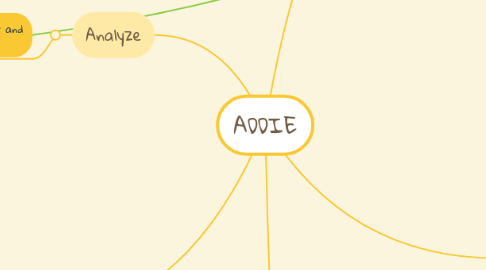
1. Analyze
1.1. Assess learning environment and training goals.
1.1.1. Define instructional goals (why is the training needed?)
1.1.2. Develop learners profiles
1.1.3. List resources
1.1.4. Outline training plan (methodology and media to be used)
1.1.5. Assess clarity, impact and feasibility of instructional goals with the client
2. Evaluate
2.1. Evaluate the course success
2.1.1. Formative evaluation is carried out throughout all the ADDIE phases (in the map it is flagged with magnifying glass icon and grey arrows/processes)
2.1.2. Summative evaluation: develop an evaluation report and actionable changes for current and future courses
2.1.2.1. Kirkpatrick's model
2.1.2.1.1. Learners' reaction to the course (e.g. was it useful, interesting...) open-ended questions can be used
2.1.2.1.2. Learning: test knowledge, achievements and attitudes (e.g. multiple choice tests)
2.1.2.1.3. Behavior: test impact of learning in performance settings
2.1.2.1.4. Results: assess impact of training on real-world settings (e.g. organisational benefits, job satisfaction, morale, confidence, etc.)
3. Design
3.1. ... make practical decisions on how the training will be developed, delivered and assessed
3.1.1. Identify and break down the learning objectives (what will the learners learn)
3.1.2. Design assessment (what will be tested and how)
3.1.3. Choose course format/delivery system
3.1.4. Create instructional strategy (content, activities and how they will be carried out and assessed)
3.1.5. Review all the above with the client
3.1.6. Create storyboard or prototype and review it with the client
4. Develop
4.1. Create (or outsource) the content and course materials and prepare training environment (LMS, classroom, etc.)
4.1.1. Develop the content/activities decided upon in the design phase
4.1.2. Review the material with the client and, if needed, with content experts
4.1.3. Ensure copyrights are cleared
4.1.4. Address technical aspects with the LMS (bugs, sessions timings, testing timings, access requirements, backups)
4.1.5. Set-up a timed run-through or pilot of the course
4.1.6. Assess individual activities with potential learners (one-to-one or small representative group)
5. Implement
5.1. Deliver the course and carry out the assessment
5.1.1. Train and prepare the instructor/s
5.1.2. Prepare and motivate the learners
5.1.3. Provide the learners with the necessary tools and knowledge
5.1.4. Arrange the learning space (overall infrastructure and tools needed)
5.1.5. Monitor the activities (including tracking system of the LMS)

